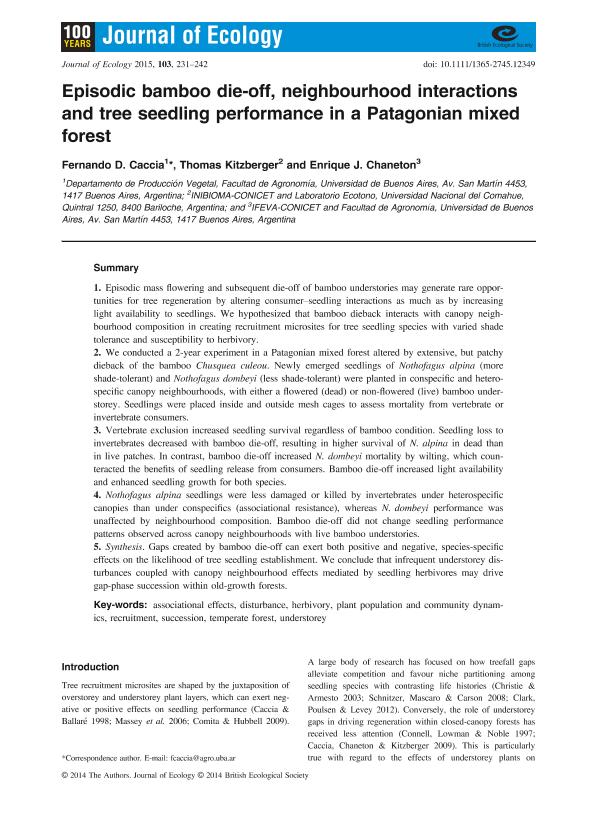Artículo
Episodic bamboo die-off, neighbourhood interactions, and tree seedling performance in a mixed Patagonian forest
Fecha de publicación:
01/2015
Editorial:
Wiley
Revista:
Journal Of Ecology
ISSN:
0022-0477
Idioma:
Inglés
Tipo de recurso:
Artículo publicado
Clasificación temática:
Resumen
1) Episodic mass flowering and subsequent die-off of bamboo understories may generate rare opportunities for tree regeneration by altering consumer–seedling interactions as much as by increasing light availability to seedlings. We hypothesized that bamboo dieback interacts with canopy neighbourhood composition in creating recruitment microsites for tree seedling species with varied shade tolerance and susceptibility to herbivory. 2) We conducted a 2-year experiment in a Patagonian mixed forest altered by extensive, but patchy dieback of the bamboo Chusquea culeou. Newly emerged seedlings of Nothofagus alpina (more shade-tolerant) and Nothofagus dombeyi (less shade-tolerant) were planted in conspecific and heterospecific canopy neighbourhoods, with either a flowered (dead) or non-flowered (live) bamboo understorey. Seedlings were placed inside and outside mesh cages to assess mortality from vertebrate or invertebrate consumers. 3) Vertebrate exclusion increased seedling survival regardless of bamboo condition. Seedling loss to invertebrates decreased with bamboo die-off, resulting in higher survival of N. alpina in dead than in live patches. In contrast, bamboo die-off increased N. dombeyi mortality by wilting, which counteracted the benefits of seedling release from consumers. Bamboo die-off increased light availability and enhanced seedling growth for both species. 4) Nothofagus alpina seedlings were less damaged or killed by invertebrates under heterospecific canopies than under conspecifics (associational resistance), whereas N. dombeyi performance was unaffected by neighbourhood composition. Bamboo die-off did not change seedling performance patterns observed across canopy neighbourhoods with live bamboo understories. 5) Synthesis. Gaps created by bamboo die-off can exert both positive and negative, species-specific effects on the likelihood of tree seedling establishment. We conclude that infrequent understorey disturbances coupled with canopy neighbourhood effects mediated by seedling herbivores may drive gap-phase succession within old-growth forests.
Palabras clave:
Associational Effects
,
Disturbance
,
Herbivory
,
Recruitment
Archivos asociados
Licencia
Identificadores
Colecciones
Articulos(IFEVA)
Articulos de INST.D/INV.FISIOLOGICAS Y ECO.VINCULADAS A L/AGRIC
Articulos de INST.D/INV.FISIOLOGICAS Y ECO.VINCULADAS A L/AGRIC
Citación
Caccia, Fernando Daniel; Kitzberger, Thomas; Chaneton, Enrique Jose; Episodic bamboo die-off, neighbourhood interactions, and tree seedling performance in a mixed Patagonian forest; Wiley; Journal Of Ecology; 103; 1; 1-2015; 231-242
Compartir
Altmétricas




